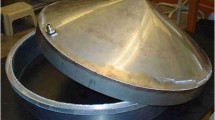Abstract
Experiments and calculations were conducted with a 0.13 mm fine wire thermocouple within a naturally-aspirated Gill radiation shield to assess and improve the accuracy of air temperature measurements without the use of mechanical aspiration, wind speed or radiation measurements. It was found that this thermocouple measured the air temperature with root-mean-square errors of 0.35 K within the Gill shield without correction. A linear temperature correction was evaluated based on the difference between the interior plate and thermocouple temperatures. This correction was found to be relatively insensitive to shield design and yielded an error of 0.16 K for combined day and night observations. The correction was reliable in the daytime when the wind speed usually exceeds 1 m s−1 but occasionally performed poorly at night during very light winds. Inspection of the standard deviation in the thermocouple wire temperature identified these periods but did not unambiguously locate the most serious events. However, estimates of sensor accuracy during these periods is complicated by the much larger sampling volume of the mechanically-aspirated sensor compared with the naturally-aspirated sensor and the presence of significant near-surface temperature gradients. The root-mean-square errors therefore are upper limits to the aspiration error since they include intrinsic sensor differences and intermittent volume sampling differences.
Similar content being viewed by others
References
Collis DC, Williams MJ (1959) Two-dimensional convection from heated wires at low Reynolds Numbers. J Fluid Mech 6: 357–389
Erell E, Leal V, Maldonado E (2005) Measurement of air temperature in the presence of a large radiant flux: an assessment of passively ventilated thermometer screens. Boundary-Layer Meteorol 114: 205–231
Friehe CA (1986) Fine-scale measurements of velocity, temperature, and humidity in the atmospheric boundary layer. In: Lenschow DH (eds) Probing the atmospheric boundary. American Meteorological Society, Boston, MA, pp 29–38
Fritschen LJ, Gay LW (1979) Environmental instrumentation. Springer-Verlag, New York, p 216
Hubbard KG, Lin X, Walter-Shea EA (2001) The effectiveness of the ASOS MMTS, Gill, and CRS air temperature radiation shields. J Atmos Oceanic Technol 18: 851–864
Lin X, Hubbard KG, Meyer GE (2001) Airflow characteristics of commonly used temperature radiation shields. J Atmos Oceanic Technol 18: 329–339
Nakamura R, Mahrt L (2005) Air temperature measurement errors in naturally ventilated radiation shields. J Atmos Oceanic Technol 22: 1046–1058
Richardson SJ, Brock FW, Semmer SR, Jirak C (1999) Minimizing errors associated with multiplate radiation shields. J Atmos Oceanic Technol 16: 1862–1872
Author information
Authors and Affiliations
Corresponding author
Rights and permissions
About this article
Cite this article
Kurzeja, R. Accurate Temperature Measurements in a Naturally-Aspirated Radiation Shield. Boundary-Layer Meteorol 134, 181–193 (2010). https://doi.org/10.1007/s10546-009-9430-2
Received:
Accepted:
Published:
Issue Date:
DOI: https://doi.org/10.1007/s10546-009-9430-2




